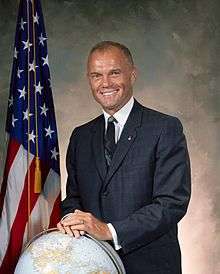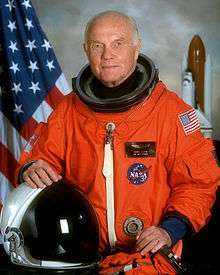John Glenn
John Herschel Glenn Jr. (born July 18, 1921), (Col, USMC, Ret.), is a former aviator, engineer, astronaut, and United States senator. He was one of the "Mercury Seven" group of military test pilots selected in 1959 by NASA to become America's first astronauts and fly the Project Mercury spacecraft.
On February 20, 1962, Glenn flew the Friendship 7 mission and became the first American to orbit the Earth and the fifth person in space, after cosmonauts Yuri Gagarin and Gherman Titov and the sub-orbital flights of Mercury astronauts Alan Shepard and Gus Grissom. Glenn is the earliest-born American to go to orbit, and the second earliest-born man overall after Soviet cosmonaut Georgy Beregovoy. Glenn received the Congressional Space Medal of Honor in 1978, and was inducted into the U.S. Astronaut Hall of Fame in 1990. With the death of Scott Carpenter on October 10, 2013, Glenn became the last surviving member of the Mercury Seven.
Glenn resigned from NASA on January 16, 1964, and the next day announced plans to run for a U.S. Senate seat from Ohio; however, a bathroom fall which resulted in a concussion caused him to withdraw from the race in March. He retired from the Marine Corps on January 1, 1965. A member of the Democratic Party, he finally won election to the Senate in 1974 and served through January 3, 1999. With the death of Edward Brooke on January 3, 2015, Glenn became the oldest living former United States Senator.
On October 29, 1998, while still a sitting senator, he became the oldest person to fly in space, and the only one to fly in both the Mercury and Space Shuttle programs, when at age 77, he flew as a Payload Specialist on Discovery mission STS-95. He was awarded the Presidential Medal of Freedom in 2012.
Early life, education and military service
John Glenn was born on July 18, 1921, in Cambridge, Ohio, the son of John Herschel Glenn, Sr. (1895–1966) and Teresa (née Sproat) Glenn (1897–1971).[2] He was raised in New Concord, Ohio.[3]
After graduating from New Concord High School in 1939, he studied Engineering at Muskingum College. He earned a private pilot license for credit in a physics course in 1941.[4] Glenn did not complete his senior year in residence or take a proficiency exam, both requirements of the school for the Bachelor of Science degree. However, the school granted Glenn his degree in 1962, after his Mercury space flight.[5]
World War II
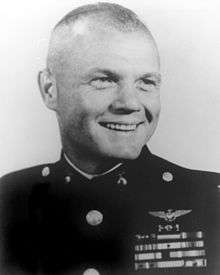
When the Japanese attack on Pearl Harbor brought the United States into World War II, Glenn quit college to enlist in the U.S. Army Air Corps. However, he was never called to duty, and in March 1942 enlisted as a United States Navy aviation cadet. He went to the University of Iowa for preflight training, then continued on to NAS Olathe, Kansas, for primary training. He made his first solo flight in a military aircraft there. During his advanced training at the NAS Corpus Christi, he was offered the chance to transfer to the U.S. Marine Corps and took it.[6]
Upon completing his training in 1943, Glenn was assigned to Marine Squadron VMJ-353, flying R4D transport planes. He transferred to VMF-155 as an F4U Corsair fighter pilot, and flew 59 combat missions in the South Pacific.[7] He saw combat over the Marshall Islands, where he attacked anti-aircraft batteries on Maloelap Atoll. In 1945, he was assigned to NAS Patuxent River, Maryland, and was promoted to captain shortly before the war's end.
Glenn flew patrol missions in North China with the VMF-218 Marine Fighter Squadron, until it was transferred to Guam. In 1948 he became a flight instructor at NAS Corpus Christi, Texas, followed by attending the Amphibious Warfare School.
Korean War
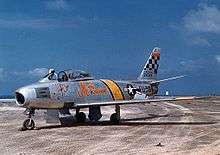
During the Korean War, Glenn was assigned to VMF-311, flying the new F9F Panther jet interceptor. He flew his Panther in 63 combat missions, gaining the nickname "magnet ass" from his alleged ability to attract enemy flak. On two occasions, he returned to his base with over 250 holes in his aircraft.[8] For a time, he flew with Marine reservist Ted Williams, a future Hall of Fame baseball player for the Boston Red Sox, as his wingman. He also flew with future Major General Ralph H. Spanjer.[9]
Glenn flew a second Korean combat tour in an interservice exchange program with the United States Air Force, 51st Fighter Wing. He logged 27 missions in the faster F-86F Sabre and shot down three MiG-15s near the Yalu River in the final days before the ceasefire.
For his service in 149 combat missions in two wars, he received numerous honors, including the Distinguished Flying Cross (six occasions) and the Air Medal with eighteen award stars.
Test pilot
Glenn returned to NAS Patuxent River, appointed to the U.S. Naval Test Pilot School (class 12), graduating in 1954. He served as an armament officer, flying planes to high altitude and testing their cannons and machine guns. He was assigned to the Fighter Design Branch of the Navy Bureau of Aeronautics (now Bureau of Naval Weapons) as a test pilot on Navy and Marine Corps jet fighters in Washington, D.C., from November 1956 to April 1959, during which time he also attended the University of Maryland.
Glenn has nearly 9,000 hours of flying time, with approximately 3,000 hours in jet aircraft.
On July 16, 1957, Glenn completed the first supersonic transcontinental flight in a Vought F8U-3P Crusader. The flight from NAS Los Alamitos, California, to Floyd Bennett Field, New York, took 3 hours, 23 minutes and 8.3 seconds. As he passed over his hometown, a child in the neighborhood reportedly ran to the Glenn house shouting "Johnny dropped a bomb! Johnny dropped a bomb! Johnny dropped a bomb!" as the sonic boom shook the town. Project Bullet, the name of the mission, included both the first transcontinental flight to average supersonic speed (despite three in-flight refuelings during which speeds dropped below 300 mph), and the first continuous transcontinental panoramic photograph of the United States. For this mission Glenn received his fifth Distinguished Flying Cross.[10]
NASA career
In 1958, the newly formed NASA began a recruiting program for astronauts. Requirements were that each had to be a military test pilot between the ages of 25 and 40 with sufficient flight hours, no more than 5'11" in height, and possess a degree in a scientific field. 508 pilots were subjected to rigorous mental and physical tests, and finally the selection was narrowed down to seven astronauts (Glenn, Alan Shepard, Gus Grissom, Scott Carpenter, Wally Schirra, Gordon Cooper, and Deke Slayton), who were introduced to the public at a NASA press conference in April 1959. Glenn just barely met the requirements as he was close to the age cutoff of 40 and also lacked the required science-based degree at the time. During this time, he remained an officer in the United States Marine Corps.

Glenn became the first American to orbit the Earth, aboard Friendship 7 on February 20, 1962, on the Mercury-Atlas 6 mission, circling the globe three times during a flight lasting 4 hours, 55 minutes, and 23 seconds.[11] This made Glenn the third American in space and the fifth human being in space.
Zero G, and I feel fine.
Perth, Western Australia, became known worldwide as the "City of Light" when residents turned on their house, car and streetlights as Glenn passed overhead.[13][14] (The city repeated the act when Glenn rode the Space Shuttle in 1998).[15][16] During the first mission there was concern over a ground indication that his heat shield had come loose, which could allow it to fail during re-entry through the atmosphere, causing his capsule to burn up. Flight controllers had Glenn modify his re-entry procedure by keeping his retrorocket pack on over the shield in an attempt to keep it in place. He made his splashdown safely, and afterwards it was determined that the indicator was faulty.

As the first American in orbit, Glenn became a national hero, met President Kennedy, and received a ticker-tape parade in New York City, reminiscent of that given for Charles Lindbergh and other great dignitaries.
Glenn's fame and political attributes were noted by the Kennedys, and he became a personal friend of the Kennedy family. On February 23, 1962, President Kennedy escorted him in a parade to Hangar S at Cape Canaveral Air Force Station, where he awarded Glenn with the NASA Distinguished Service Medal.
In July 1962 Glenn testified before the House Space Committee in favor of excluding women from the NASA astronaut program. Although NASA had no official policy prohibiting women, in practice the requirement that astronauts had to be military test pilots excluded them entirely.[17] The impact of the testimony of so prestigious a hero is debatable, but no female astronaut flew on a NASA mission until Sally Ride in 1983 (in the meantime, the Soviets had flown two women on space missions), and none piloted a mission until Eileen Collins in 1995, more than 30 years after the hearings. In the late 1970s, Glenn is reported to have supported Shuttle Mission Specialist Astronaut Judith Resnik in her career.[18]
Glenn resigned from NASA on January 16, 1964, and the next day announced his candidacy as a Democrat for the U.S. Senate from his home state of Ohio. On February 26, 1964, Glenn suffered a concussion from a slip and fall against a bathtub; this led him to withdraw from the race on March 30.[19][20] Glenn then went on convalescent leave from the Marine Corps until he could make a full recovery, necessary for his retirement from the Marines. He retired on January 1, 1965, as a Colonel and entered the business world as an executive for Royal Crown Cola.
Political career
U.S. Senate
NASA psychologists had determined during Glenn's training that he was the astronaut best suited for public life.[21] Attorney General Robert F. Kennedy suggested to Glenn and his wife in December 1962 that he should run against incumbent United States Senator Stephen M. Young of Ohio in the 1964 Democratic primary election. In 1964 Glenn announced that he was resigning from the space program to run against Young, but withdrew when he hit his head on a bathtub. Glenn sustained a concussion and injured his inner ear, and recovery left him unable to campaign.[22] Glenn remained close to the Kennedy family and was with Robert Kennedy when he was assassinated in 1968.
In 1970, Glenn was narrowly defeated in the Democratic primary for nomination for the Senate by fellow Democrat Howard Metzenbaum, by a 51% to 49% margin. Metzenbaum lost the general election race to Robert Taft, Jr. In 1974, Glenn rejected Ohio governor John J. Gilligan and the Ohio Democratic party's demand that he run for Lieutenant Governor. Instead, he challenged Metzenbaum again, whom Gilligan had appointed[22] to the Senate to replace William B. Saxbe, who had resigned to become Attorney General of the United States.
In the primary race, Metzenbaum contrasted his strong business background with Glenn's military and astronaut credentials, saying his opponent had "never held a payroll". Glenn's reply came to be known as the "Gold Star Mothers" speech. He told Metzenbaum to go to a veterans' hospital and "look those men with mangled bodies in the eyes and tell them they didn't hold a job. You go with me to any Gold Star mother and you look her in the eye and tell her that her son did not hold a job." Many felt the "Gold Star Mothers" speech won the primary for Glenn. Glenn won the primary by 54 to 46%. After defeating Metzenbaum, Glenn defeated Ralph Perk, the Republican Mayor of Cleveland, in the general election, beginning a Senate career that would continue until 1999. In 1980, Glenn won re-election to the seat, defeating Republican challenger Jim Betts, by over 40 percentage points.
In 1986, Glenn defeated challenger U.S. Representative Tom Kindness. Metzenbaum would go on to seek a rematch against Taft in 1976, winning a close race on Jimmy Carter's coattails.
In the late 1970s and early 1980s, Glenn and Metzenbaum had strained relations. There was a thaw in 1983, when Metzenbaum endorsed Glenn for president, and again in 1988, when Metzenbaum was opposed for re-election by Cleveland mayor George Voinovich. Voinovich accused Metzenbaum of being soft on child pornography. Voinovich's charges were criticized by many, including Glenn, who now came to Metzenbaum's aid, recording a statement for television rebutting Voinovich's charges. Metzenbaum won the election by 57% to 41%.
Savings and loan scandal
Glenn was one of the five U.S. senators caught up in the Lincoln Savings and Keating Five Scandal after accepting a $200,000 contribution from Charles Keating. Glenn and Republican senator John McCain were the only senators exonerated. The Senate Commission found that Glenn had exercised "poor judgment". The association of his name with the scandal gave Republicans hope that he would be vulnerable in the 1992 campaign. Instead, Glenn defeated Lieutenant Governor Mike DeWine to keep his seat, though his percentage was reduced to a career low of 51%. DeWine used the memorable campaign slogan, "What on earth has John Glenn done?"[23] This 1992 re-election victory was the last time a Democrat won a statewide race in Ohio until 2006; DeWine later won Metzenbaum's seat upon his retirement.
Presidential politics
In 1976, Glenn was a candidate for the Democratic vice presidential nomination. However, Glenn's keynote address at the Democratic National Convention failed to impress the delegates and the nomination went to veteran politician Walter Mondale. Glenn also ran for the 1984 Democratic presidential nomination. A November 1983 New York Times/CBS News poll found him second, supported by 41% of those polled, to Mondale's 49%.
Glenn and his staff worried about the 1983 release of The Right Stuff, a film about the original seven Mercury astronauts based on the best-selling Tom Wolfe book of the same name. The book had depicted Glenn as a "zealous moralizer", and he did not attend the film's Washington premiere on October 16, 1983. Reviewers saw Ed Harris' portrayal of Glenn as heroic, however, and his staff immediately began to emphasize the film to the press. Aide Greg Schneiders suggested an unusual strategy, similar to Glenn's personal campaign and voting style, in which he would avoid appealing to narrow special interest groups and instead seek to win support from ordinary Democratic primary voters, the "constituency of the whole".[22] Mondale defeated Glenn for the nomination however, and he was left with $3 million in campaign debt for over 20 years before he was granted a reprieve by the Federal Election Commission.[24][25] He was a potential vice presidential running mate in 1984, 1988, and 1992.
Issues
During Glenn's time in the Senate, he was chief author of the Nuclear Non-Proliferation Act of 1978, served as chairman of the Committee on Governmental Affairs from 1987 until 1995, sat on the Foreign Relations and Armed Services committees and the Special Committee on Aging. Once Republicans regained control of the Senate, Glenn also served as the ranking minority member on a special Senate investigative committee chaired by Tennessee senator Fred Dalton Thompson that looked into illegal foreign donations by China to U.S. political campaigns for the 1996 election. There was considerable acrimony between the two very high-profile senators during the life of this committee, which reached a level of public disagreement between the five leaders of a congressional committee seldom seen in recent years, amid allegations that Glenn suppressed these issues prior to his subsequent Space Shuttle flight which had to be approved by President Clinton.[26] In 1998, Glenn declined to run for re-election. Mary O. Boyle was the Democratic party nominee. She faced Republican nominee and sitting governor George Voinovich in the general election, which Voinovich won.
Return to space
Glenn returned to space on the Space Shuttle on October 29, 1998, becoming, at age 77, the oldest person to go into space as a Payload Specialist on Discovery's STS-95 mission. According to The New York Times, Glenn "won his seat on the Shuttle flight by lobbying NASA for two years to fly as a human guinea pig for geriatric studies", which were named as the main reasons for his participation in the mission.[27] Glenn states in his memoir that he had no idea NASA was willing to send him back into space when NASA announced the decision.[28]
Glenn's participation in the nine-day mission was criticized by some in the space community as a political favor granted to Glenn by President Clinton. It was noted that Glenn's flight offered valuable research on weightlessness and other aspects of space flight on the same person at two points in life 36 years apart—by far the longest interval between space flights by the same person—providing information on the effects of spaceflight and weightlessness on the elderly, with an ideal control subject.[29] Shortly before the flight, researchers learned that Glenn had to be disqualified from one of the flight's two main priority human experiments (about the effects of melatonin) because he did not meet one of the study's medical conditions; he still participated in two other experiments about sleep monitoring and protein use.[27][29]
Upon the safe return of the STS-95 crew, Glenn (and his crewmates) received another ticker-tape parade, making him the tenth, and latest, person to have received multiple ticker-tape parades in a lifetime (as opposed to that of a sports team).[30] Just prior to the flight, on October 15, 1998, and for several months after, the main causeway to the Johnson Space Center, NASA Road 1, was temporarily renamed "John Glenn Parkway".
In 2001, Glenn vehemently opposed the sending of Dennis Tito, the world's first space tourist, to the International Space Station on the grounds that Tito's trip served no scientific purpose.[31]
Public affairs institute
Glenn helped found the John Glenn Institute for Public Service and Public Policy at The Ohio State University in 1998 to encourage public service. On July 22, 2006, the institute merged with OSU's School of Public Policy and Management to become the John Glenn School of Public Affairs. Today Glenn holds an adjunct professorship at the Glenn School.[32] In February 2015, it was announced that the School would become the John Glenn College of Public Affairs beginning in April 2015.[33]
Personal life

On April 6, 1943, Glenn married his childhood sweetheart, Anna Margaret Castor (b. 1920). Both Glenn and his wife attended Muskingum College in New Concord, Ohio. He also was a member of the Stag Club Fraternity at Muskingum College.[34]
Glenn was also one of the original owners of a Holiday Inn franchise near Orlando, Florida, that is today known as the Seralago Hotel & Suites Main Gate East.[35][36]
Glenn is an honorary member of the International Academy of Astronautics; a member of the Society of Experimental Test Pilots, Marine Corps Aviation Association, Order of Daedalians, National Space Club Board of Trustees, National Space Society Board of Governors, International Association of Holiday Inns, Ohio Democratic Party, State Democratic Executive Committee, Franklin County (Ohio) Democratic Party, and 10th District (Ohio) Democratic Action Club.[4]
A Freemason, Glenn is a member of Concord Lodge # 688 New Concord, Ohio, and DeMolay International, the Masonic youth organization, and is an ordained elder in the Presbyterian Church.[37]
Glenn's name was used for the character of John Tracy in the 1960s children's TV series Thunderbirds.
Glenn's boyhood home in New Concord has been restored and made into an historic house museum and education center.[38]
In 2001, Glenn appeared as a guest star on the American television sitcom Frasier.[39]
On August 4, 2006, Glenn and his wife were injured in an automobile accident on I-270 near Columbus, Ohio, and were hospitalized for two days. Glenn suffered a "very sore chest" and a fractured sternum. Annie Glenn was treated for minor injuries. Glenn was cited for failure to yield the right-of-way.[40]
On September 5, 2009, John and Annie Glenn dotted the "i" during The Ohio State University's Script Ohio marching band performance, at the Ohio State-Navy football game halftime show. Bob Hope, Woody Hayes, Buster Douglas, E. Gordon Gee, Novice Fawcett, Robert Ries, and Jack Nicklaus and Earle Bruce are the only other non-band members to have received this honor.[41]
On February 20, 2012, to commemorate the 50th anniversary of the Friendship 7 flight, Glenn was surprised with the opportunity to speak with the orbiting crew of the International Space Station while Glenn was on-stage with NASA Administrator Charlie Bolden at Ohio State, where the public affairs school is named for him.[42]
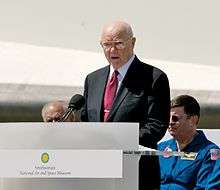
On April 19, 2012, Glenn participated in the ceremonial transfer of the retired Space Shuttle Discovery from NASA to the Smithsonian Institution for permanent display at the Steven F. Udvar-Hazy Center. Speaking at the event, Glenn criticized the "unfortunate" decision to end the Space Shuttle program, expressing his opinion that grounding the shuttles delayed research.[43]
On June 28, 2016, the Columbus, Ohio airport was officially renamed the John Glenn Columbus International Airport. Just before his 95th birthday, Glenn and his wife Annie attended the ceremony, and he spoke eloquently about how visiting that airport as a child inspired his interest in flying. [44]
Glenn has stated that he sees no contradiction between believing in God and the knowledge that evolution is "a fact", and that he believes evolution should be taught in schools.[45]
Image gallery
-

Glenn at the Mercury Control Center on the Cape Canaveral Air Force Base
-
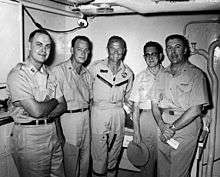
Medical debriefing of Major John H. Glenn, Jr., USMC after orbital flight of Friendship 7 on February 20, 1962 aboard the aircraft carrier USS Randolph (CVS-15). The debriefing team for Lt. Colonel Glenn (center) was led by Commander Seldon C. "Smokey" Dunn, MC, USN (FS) (RAM-qualified) (far right w/EKG in hands).
-

"Best regards and many thanks for all the help, 'Smokey'
John H. Glenn Jr
Mercury Astronaut
a good date -- 20 February 62" -

Plaque near Mercury launch pad
Awards and honors
 | |||
- Congressional Gold Medal
- The Woodrow Wilson Award
- National Geographic Society's Hubbard Medal, 1962
- John J. Montgomery Award, 1963
- Golden Plate Award for Science and Exploration, 1964
- General Thomas D. White National Defense Award.[46]
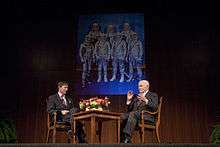
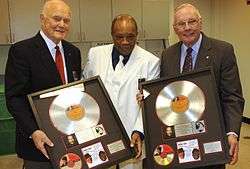
The NASA John H. Glenn Research Center at Lewis Field in Cleveland, Ohio, is named after him. Also, Senator John Glenn Highway runs along a stretch of I-480 in Ohio across from the NASA Glenn Research Center. Colonel Glenn Highway, which runs by Wright-Patterson Air Force Base and Wright State University near Dayton, Ohio, John Glenn High School in his hometown of New Concord, Ohio, and Col. John Glenn Elementary in Seven Hills, Ohio, are named for him as well. High Schools in Westland and Bay City, Michigan; Walkerton, Indiana; San Angelo, Texas; Elwood, Long Island, New York; and Norwalk, California were also named after him.
The fireboat John H. Glenn Jr. was named for him. This fireboat is operated by the DCFD and protects the sections of the Potomac River and the Anacostia River that run through Washington, D.C.
The USNS John Glenn (T-MLP-2), a mobile landing platform that is scheduled to be delivered to the U.S. Navy in 2014 is named for him. It was christened February 1, 2014, in San Diego at General Dynamics’ National Steel and Shipbuilding Company.[47]
In 1961, Glenn received an Honorary LL.D from Muskingum University, the college he had attended before joining the military in World War II.[5]
He also received Honorary Doctorates from Nihon University in Tokyo, Japan, Wagner College in Staten Island, New York, and New Hampshire College in Manchester, New Hampshire.
Glenn was enshrined in the National Aviation Hall of Fame in 1976.[48]
Glenn was inducted into the International Space Hall of Fame in 1977.[12]
In 1990, Glenn was inducted into the U.S. Astronaut Hall of Fame.[49]
In 2000, Glenn received the U.S. Senator John Heinz Award for Greatest Public Service by an Elected or Appointed Official, an award given out annually by Jefferson Awards.[50]
In 2004, Glenn was awarded the Woodrow Wilson Award for Public Service by the Woodrow Wilson International Center for Scholars of the Smithsonian Institution.[51]
In 2009, Glenn received an Honorary LL.D from Williams College,[52] and in 2010, he received an Honorary Doctorate of Public Service from Ohio Northern University.[53]
In 2013, Flying magazine ranked Glenn No. 26 on their "51 Heroes of Aviation" list.[54]
On January 3, 2015, with the death of Edward Brooke, Glenn became the oldest former United States senator still living. Glenn is the 60th person to hold this distinction.
On September 12, 2016, Blue Origin announced a new rocket named after Glenn, the New Glenn.[55]
Physical description
- Weight: 170 lb (77 kg)
- Height: 5 ft 10½ in (1.79 m)
- Hair: Red
- Eyes: Green[4]
See also
- List of spaceflight records
- The John Glenn Story, a 1962 documentary film
- Project Mercury Commemorative stamp
References
- ↑ "Ohio" (PDF). Congressional Pictorial Directory, 105th Congress. 1997. p. 104.
- ↑ "John Glenn Archives, Audiovisuals Subgroup, Series 3: Certificates". Library.osu.edu. Archived from the original on 2014-12-21. Retrieved August 30, 2013.
- ↑ Kupperberg, Paul (November 1, 2003). John Glenn: The First American in Orbit and His Return to Space. The Rosen Publishing Group. p. 15. ISBN 978-0-8239-4460-6.
- 1 2 3 "40th Anniversary of Mercury 7: John Herschel Glenn, Jr". History.nasa.gov. Retrieved 2015-04-24.
- 1 2 (4 October 1983), "College says Glenn degree was deserved", The Day (New London, CT).
- ↑ "John Glenn: Biographical Sketch". Ohio Statue University. 2009. Archived from the original on 2009-10-17.
- ↑ Shettle USMC Air Station of WWII, p. 167
- ↑ Mersky USMC Aviation, p. 183
- ↑ "Ralph H. Spanjer, 78". Chicago Tribune. February 12, 1999.
- ↑ Glenn, John; Taylor, Nick (November 2, 1998). John Glenn: A Memoir. Bantam. p. 169. ISBN 978-0-553-11074-6.
- ↑ "Glenn Orbits the Earth". NASA. Retrieved June 10, 2008.
- 1 2 "International Space Hall of Fame :: New Mexico Museum of Space History :: Inductee Profile". Nmspacemuseum.org. Retrieved 2015-04-24.
- ↑ (1970) Perth – a city of light Perth, W.A. Brian Williams Productions for the Government of WA, 1970 (Video recording) The social and recreational life of Perth. Begins with a 'mock-up' of the lights of Perth as seen by astronaut John Glenn in February 1962
- ↑ Gregory, Jenny. "Biography - Sir Henry Rudolph (Harry) Howard - Australian Dictionary of Biography". Adbonline.anu.edu.au. Retrieved August 30, 2013.
- ↑ Australian Broadcasting Corporation (February 15, 2008). "Moment in Time – Episode 1". Retrieved July 14, 2008.
- ↑ Moore, Charles (November 5, 1998). "Grandfather Glenn's blast from the past". The Daily Telegraph (UK). London. Retrieved July 14, 2008.
- ↑ , The Globe and Mail, October 12, 2002 Archived September 13, 2004, at the Wayback Machine.
- ↑ Kevles, ettyann Holtzmann (2003). Almost Heaven: the Story of Women in Space. New York: Basic Books. p. 98. ISBN 0-7382-0209-6.
- ↑ Pett, Saul. "John Glenn's Irony: He Fights for Balance." The Nashville Tennessean, May 10, 1964, p. 2.
- ↑ Mattson, Dr. Richard H. "Doctors Urge He Quit Race." New York Times, March 31, 1964, p. 19.
- ↑ Catchpole 2001, p. 96.
- 1 2 3 Raines, Howell (November 13, 1983). "John Glenn: The Hero as Candidate". The New York Times. p. 40. Retrieved May 14, 2011.
- ↑ Clifford Krauss Krauss, Clifford (October 15, 1992). "In Big Re-election Fight, Glenn Tests Hero Image". The New York Times. Retrieved July 21, 2008.
- ↑ Luce, Edward (May 9, 2008). "Well of donors dries up for Clinton". Ft.com. Retrieved August 30, 2013.
- ↑ "For Clinton, Millions in Debt and Few Options". The New York Times. Retrieved 2015-04-24.
- ↑ "Fred Thompson's Big Flop". Portfolio.com. October 15, 2007. Retrieved August 30, 2013.
- 1 2 Altman, Lawrence K. (October 21, 1998). "Glenn Unable to Perform Experiment Planned for Space Flight". The New York Times. Retrieved February 15, 2014.
- ↑ Glenn, John; Taylor, Nick (November 2, 1998). John Glenn: A Memoir. Bantam. p. 231. ISBN 978-0-553-11074-6.
- 1 2 Brian Riley (2012). "Interview with John Glenn". Davis, California: BrianRiley.us. Retrieved August 17, 2014.
Now, here on Earth your body’s immune system changes somewhat when you get older and you become less resistant to disease and infection. The same thing happens to younger astronauts in space over a period of time. Another one is, as you get older, your body’s ability to replace protein in the muscles becomes less, and the same thing happens to younger astronauts during long-term space flight. There are several other things like that.
- ↑ List of ticker-tape parades in New York City
- ↑ "John Glenn: Space tourist cheapening Alpha". CNN. May 3, 2001. Archived from the original on October 6, 2008. Retrieved May 6, 2010.
- ↑ Archived December 7, 2014, at the Wayback Machine.
- ↑ "Welcome to John Glenn College of Public Affairs | The Columbus Dispatch". Dispatch.com. 2015-02-04. Retrieved 2015-04-24.
- ↑ PRNewswire. "1963 Muskingum Grad to Conduct Solar Experiments Aboard Oct. 29 Shuttle Flight with Muskie John Glenn on Board". Retrieved 24 September 2015.
- ↑ Archived February 22, 2014, at the Wayback Machine.
- ↑ Landwirth, Henri. Gift of Life.
- ↑ Kupperberg, Paul (2003). John Glenn. New York: The Rosen Publishing Group. p. 96. ISBN 9780823944606. Retrieved July 24, 2009.
- ↑ "The John & Annie Glenn — Historic Site". Johnglennhome.org. Retrieved 2015-04-24.
- ↑ Archived May 14, 2013, at the Wayback Machine.
- ↑ "John Glenn and wife released from hospital". Wkyc.com. August 6, 2006. Retrieved August 30, 2013.
- ↑ "The "i"-Dot Tradition". Retrieved September 1, 2009.
- ↑ Kantele Franko (February 20, 2012). "Armstrong honors Glenn 50 years after his orbit – NASA also surprised Glenn with space station chat". MSNBC. Retrieved February 21, 2012.
- ↑ Brett Zongker (April 20, 2012). "Shuttle Discovery lands at Smithsonian". philly.com. Retrieved April 21, 2012.
- ↑ http://www.dispatch.com/content/stories/business/2016/06/28/0628-john-glenn-honored-at-airport-renaming-ceremony.html
- ↑ "John Glenn Says Evolution Should Be Taught In Schools". The Huffington Post. May 20, 2015. Retrieved May 22, 2015.
- ↑ Archived May 12, 2013, at the Wayback Machine.
- ↑ Navy christens USNS John Glenn, Pueblo Chieftain, February 1, 2014, retrieved February 1, 2014.
- ↑ "National Aviation Hall of fame: Our Enshrinees". National Aviation Hall of Fame. Retrieved February 10, 2011.
- ↑ "John Glenn | Astronaut Scholarship Foundation". Astronautscholarship.org. Retrieved 2015-04-24.
- ↑ "National Winners | public service awards". Jefferson Awards.org. Retrieved August 30, 2013.
- ↑ "Recipients of the Woodrow Wilson Award for Public Service" Woodrow Wilson International Center for Scholars. Retrieved November 18, 2011
- ↑ "Honorary Degrees | Office of the President". President.williams.edu. Retrieved 2015-04-24.
- ↑ Tyrel Linkhorn. "Honorary doctorate degree for John Glenn" (May 24, 2010). Lima News.
- ↑ "51 Heroes of Aviation | Flying Magazine". Flyingmag.com. Retrieved 2015-04-24.
- ↑ Victor, Daniel (September 12, 2016). "Meet New Glenn, the Blue Origin Rocket That May Someday Take You to Space". New York Times. Retrieved September 13, 2016.
Further reading
- Glenn, John H.; Taylor, Nick (2000). John Glenn: A Memoir. New York: Bantam Books. ISBN 0-553-58157-0.
- Fenno, Richard F., Jr. The Presidential Odyssey of John Glenn. CQ Press, 1990. 302 pp.
- Mersky, Peter B. (1983). U.S. Marine Corps Aviation — 1912 to the present. Annapolis, Maryland: The Nautical and Aviation Publishing Company of America. ISBN 0-933852-39-8.
- Shettle Jr., M. L. (2001). United States Marine Corps Air Stations of World War II. Bowersville, Georgia: Schaertel Publishing Co. ISBN 0-9643388-2-3.
External links
| Wikimedia Commons has media related to John Glenn. |
| Wikiquote has quotations related to: John Glenn |
- United States Congress. "John Glenn (id: G000236)". Biographical Directory of the United States Congress.
- Appearances on C-SPAN
- Tara Gray. "Glenn's official NASA biography for 40th Anniversary of Mercury 7". 40th Anniversary of NASA. Retrieved November 26, 2006.
- "COLONEL JOHN H. GLENN, JR., USMC(RETIRED)". Who's Who in Marine Corps History. Retrieved December 18, 2006.
- NASA — John Glenn: A Journey
- The John Glenn Story (1962)
- John Glenn Honored as an Ambassador of Exploration
- John & Annie Glenn Historic Site and Home
- John Glenn Information at the web site of the John Glenn School of Public Affairs at The Ohio State University
- Glenn's official NASA short biography
- John Glenn's Flight on Friendship 7, MA-6 – as heard on KCBS Radio at the Wayback Machine (archived October 27, 2009)
- John Glenn's Flight on Friendship 7, MA-6 – complete 5-hour capsule audio recording
- John Glenn's Flight on the Space Shuttle, STS-95
- Iven C. Kincheloe Awards
- John Glenn at the Internet Movie Database
- John Glenn at the National Aviation Hall of Fame
- Glenn at Spaceacts
- About John Glenn
- Glenn at Encyclopedia of Science
- Glenn at International Space Hall of Fame
- Astronautix biography of John Glenn
- Spacefacts biography of John Glenn
- John Glenn Archive
- John Glenn: Unpublished Photos — slideshow by Life magazine
- John Glenn: A Life of Service — PBS Video
| Party political offices | ||
|---|---|---|
| Preceded by John Gilligan |
Democratic nominee for Senator from Ohio (Class 3) 1974, 1980, 1986, 1992 |
Succeeded by Mary Boyle |
| United States Senate | ||
| Preceded by Howard Metzenbaum |
United States Senator (Class 3) from Ohio 1974–1999 Served alongside: Robert Taft, Howard Metzenbaum, Mike DeWine |
Succeeded by George Voinovich |
| Preceded by William Roth |
Chairperson of Senate Governmental Affairs Committee 1987–1995 |
Succeeded by William Roth |
| Honorary titles | ||
| Preceded by Edward Brooke |
Oldest living United States Senator 2015–present |
Incumbent |

